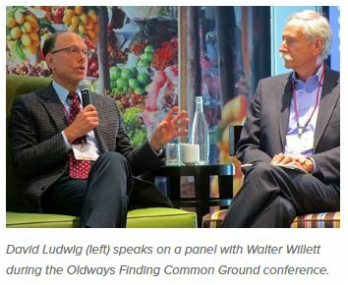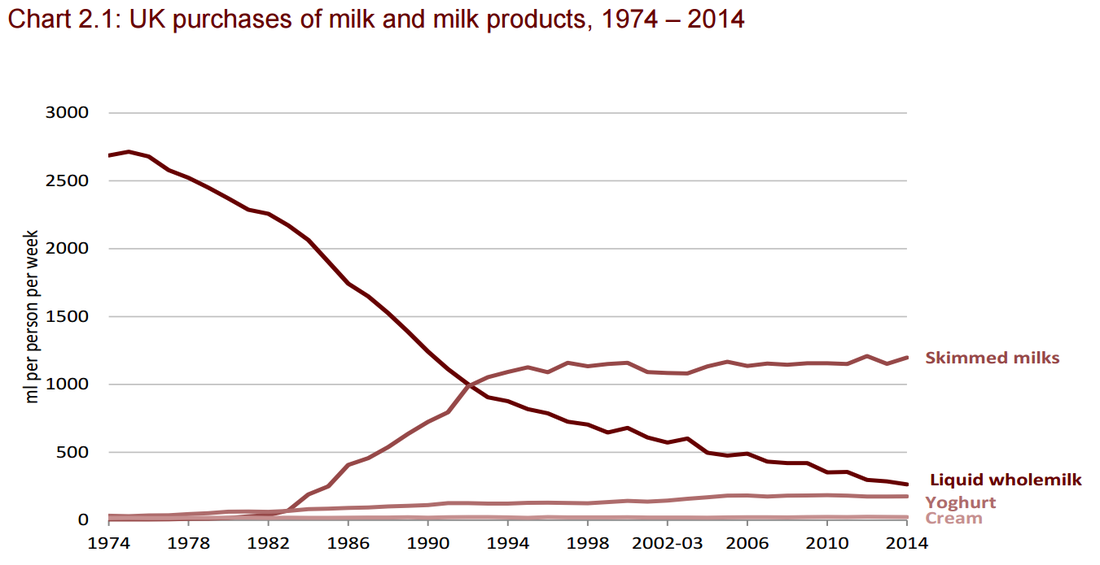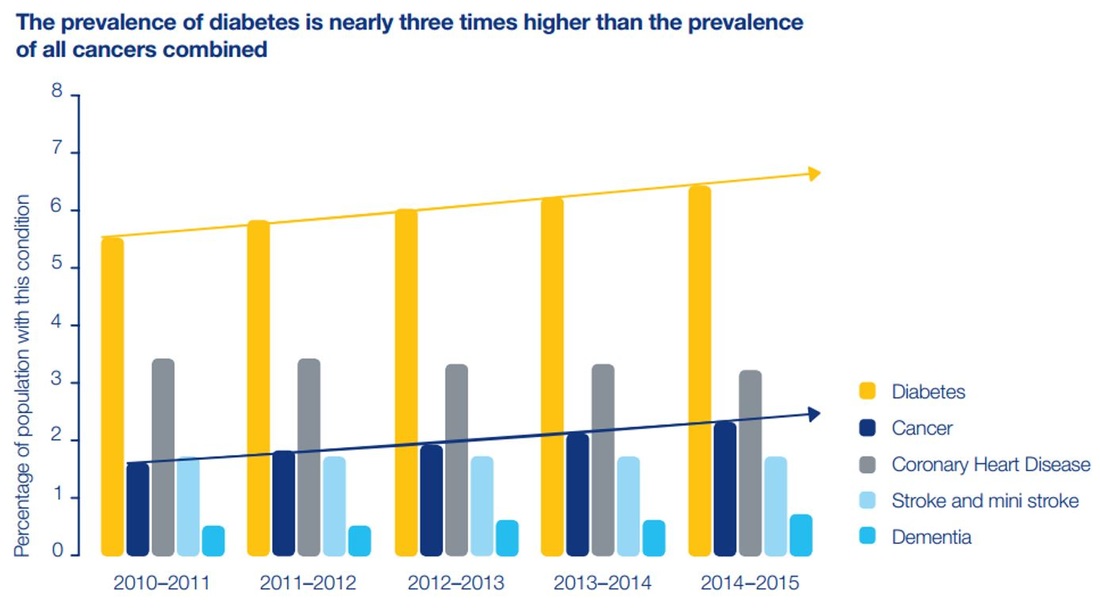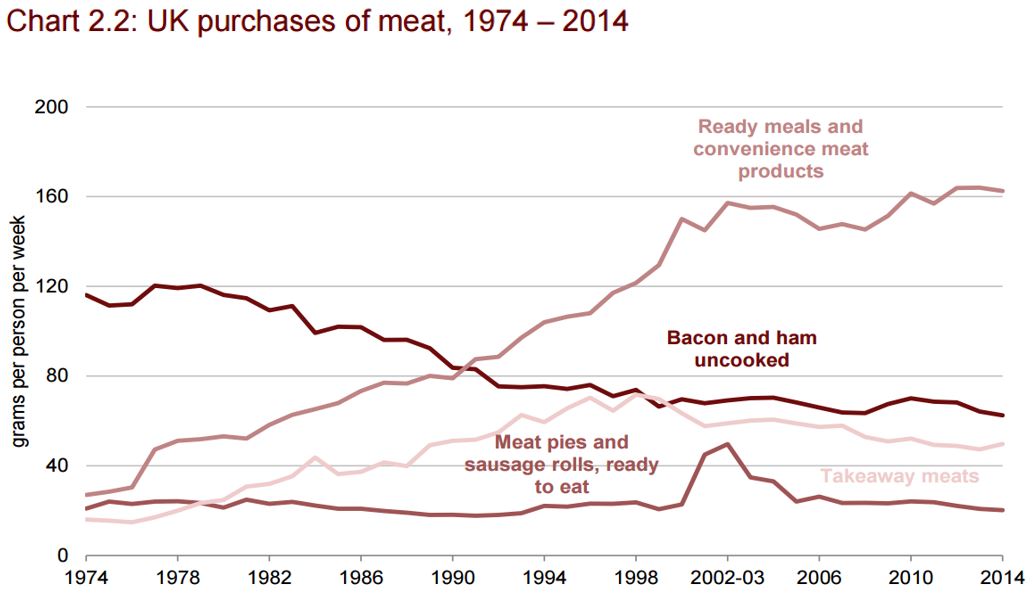|
An open letter Dear Mr Average: I know you don’t exist. The ‘average’ British citizen is only the sum total of what all Brits do divided by the total population. And yet I suspect that there are enough of you out there who fit the bell curve statistic, which indicates that 30-50% only vary in small ways from that average. So please forgive my impertinence and allow this small interruption in your eating life. You see: The conventional dietary/nutrition establishment would have you believe that you eat too much, particularly those nasty animal fats, and that you probably don’t exercise enough. That’s why over the years, if you are indeed an ‘average’ Brit, you have steadily been putting on the pounds; and as you'll know, increased weight is associated with various chronic diseases, notably certain cancers, Alzheimer’s and type-2 diabetes.  From the Conde Nast Collection From the Conde Nast Collection Obedient citizens To counter this, you may well have been prescribed fitness programmes and were probably also told to drink fat-free milk, eat less red meat but more chicken, use more vegetable oils and above all, avoid bacon and salt. This message started about 40 years ago and was officially formalized in the first UK food guidelines that were issued over 20 years ago. Now, the British public is not usually seen as being a pushover, a nation peopled by those who unquestionably do just what they are told. But in this case, the funny thing is – well it’s not at all funny really; that is exactly what you’ve done. As obedient citizens, you have followed the dietary guidelines and as an unintended consequence, you are getting fatter and ‘iller’, if that word exists. Some bad joke! The real and surprising facts are: 1/ You eat less food in total than you did 40 years ago – not more. 2/ You eat much less of that bad beef, lamb and pork. 3/ You eat much, much more ‘healthy’ white meat (chicken). 4/ You have cut right back on butter and cheese. 5/ You eat much less bacon and ham. 6/ You have almost stopped drinking regular milk because it’s full of saturated fat which clogs your arteries …and, and, and. 7/ You’ve even cut back on salt Yet incidences of diabetes and cancers continue to be on the rise, as is dementia which an increasing number of doctors refer to as type-3 diabetes. And, incidentally, the mortality statistics for heart disease and strokes have barely changed in recent years. “But aren’t we all just living longer so that disease is inevitably catching up with us?” I hear you say. Well, no. The highest prevalence of diabetes is with overweight 15-54 year olds, not among the oldest in our society. Something is making us ‘iller’, younger. Less meat, less dairy, less fat but more chronic disease? Since 1974, beef sales per person per week have almost halved to around 100 grams, and that’s down from 250 grams in post-war Britain (1950). Lamb and mutton sales are down by over two-thirds and as for milk, you’ve fundamentally changed your habits because of that fear of fat imposed by the so-called nutrition experts. The same change which has led you to believe that drinking semi-skimmed milk is quite normal, is also reflected in lower butter and cheese sales and your decision to switch from cooking with animal fats to using vegetable and seed oils. So called ‘healthy’ white meat in the form of chicken has exploded onto the scene with intensively (mostly) produced birds providing your main source of meat at 300 grams per week in all its many forms from Sunday roasts to chicken nuggets. Compare that to 1950 when you (or your parents or grandparents) used to eat around 19 grams of chicken per week. The real problem is staring you in the face Highly processed foods in the form of ready meals and snacks have completely changed how you eat and together with take-away food, they now represent around half of what you eat. Along with the huge increase in vegetable seed oils such as sunflower, corn and soy, they represent what has changed most in your diet and… to be frank, it’s not doing you any good. The decline in family meals certainly plays a role as does your desire to eat regular snacks which is now seen as normal. Long gone are the times when at about 3 pm in the afternoon, the office tea-lady would wheel round a cuppa and a piece of home-made fruit cake for that once daily snacking opportunity! More recently of course, sugar has begun to get a bad rap and in larger doses, it certainly is not good for you. But only when sugar is combined with all those artificial sweeteners, stabilizers, emulsifiers and flavour-enhancers before being made into ready-made meals, soft drinks and snacks do you run into real problems. Grandma’s home-made jams, cakes and crumbles may have used some sugar but first, they represented occasional treats, and second, they brought out the best of nature’s natural bounty. Where can I get sensible, fact-based advice? There is help at hand. The Public Health Collaboration has been established by a group of doctors and well-informed nutritionists with their feet firmly placed on the ground, and their sensible advice on how to eat and what to eat is available at www.phcuk.org. They also provide links to where you can get the best advice if you are either over-weight or suffering from the early stages of type-2 diabetes. Although those well-meaning folks who designed the original food guidelines and current Eatwell Plates meant no harm, they did not fully check their facts or examine the research back to its origins. The PHCUK members have come to understand that you are not getting ‘iller’ because you don’t follow the guidelines. It is much more likely that you are less healthy precisely because you have been following the guidelines. Main Source:
https://www.gov.uk/government/uploads/system/uploads/attachment_data/file/485982/familyfood-2014report-17dec15.pdf Next annual update due soon: Dec 2016
3 Comments
 Dr David Ludwig seems to be the only one at Harvard who supports and actively encourages low-carb, high fat diets. Those of us who have either personally experienced the benefits of a low-carb, high-fat lifestyle, or have seen its amazing effect on others continue to be baffled by the stream of ‘conventional wisdom’ which emanates from the Department of Nutrition at Harvard University. One voice providing a notable exception to that is Dr David Ludwig, an eminent Professor within that same department. He clearly leans in the higher fat, lower carb direction and yet in its PR releases, the Harvard news-team still tries to project an image of harmony and agreement which collectively supports establishment thinking. Although he is featured in the lead photo discussing a ‘common ground in nutrition’ on the Harvard website, he notably did not form part of the group which gave ‘strong, collective support’ to the Recommendations of the 2015 Dietary Guidelines Committee. In fact, not only was he absent from the Scientific Consensus Committee co-chaired by his ‘boss’, Walter Willett and Yale University’s David Katz, but he also was not one of the 9 additional signatories.
Dr Ludwig believes that traditional advice such as “Eat less, move more” is doomed to failure and in a recent interview with Experience Life magazine, he expressed his opinions about low-carb diets which over time, seem to be hardening in their conviction. Beginning with a definition, he says that to be truly classified as a low-carb diet, you need to get to around the 20% level, in terms of total calorific input or just below. This is in stark contrast with the current US (and UK) average of between 55 - 60%. Simply counting calories and cutting back on protein, carbohydrate and fat at the same time makes no sense to him. In fact, it’s epitomized by the yo-yo dieting so many people experience with Weight-Watcher style approaches, as a battle develops between your mind and your metabolism. He suggests that your starting point should be to consider the hormonal and metabolic effects of food. When you take that approach, you don’t count calories and go about things differently. Insulin is in many ways the master hormone and given the direct impact of carbohydrates on insulin levels, Dr Ludwig believes that is the best place to start lowering food intake. And because fats and protein stimulate the ‘satiety’ hormone ghrelin, that means you don’t go hungry. Interestingly, he refers to type-2 diabetes which is being increasingly seen as a disease of carbohydrate intolerance, as the ultimate metabolic breakdown! In the latest issue of Time Magazine, Dr Ludwig is even more direct: “Like a cattle rancher, insulin herds sugar and the other calories from your meal into storage, which usually means your fat cells. This not only promotes weight gain, but it also tricks your body into believing you need more energy to satisfy your body’s needs, which in turn causes your hunger to rebound rapidly. If you also happen to be on a low-fat diet high in processed foods, all of this is intensified” Ludwig says. At this stage, I will note that research also supports the widely held opinion that semi-starvation diets (also known as calorie-controlled diets) lead in most cases to that famous yo-yo effect. Infamously, most participants in the US Reality TV series, The Biggest Loser, found that their metabolism worked more slowly after their intense dieting. As a result, they had to continue their lives while eating less (effectively having a permanent feeling of hunger) or put on weight… which they invariable did. It is very sad to note that a number of successful contestants even weigh more now than when they started on their ultra-aggressive, calorie controlled diets. But back to Dr Ludwig; as many readers will know, the ultra-efficient weight loss approach if you are low-carbing is known as going ‘ketogenic’ where you get as close to zero carbs as possible and your body uses body fat as its prime source of energy. It works for many, but Dr Ludwig states that dropping to 20% carbs will also bring many health and weight-loss benefits. He reminds us that an important principle of modern biology is that going 50% of the way usually brings 90% of the benefits. Dropping to 20% carb intake or below invariably means cutting out all junk food since carbohydrates are their major ingredient. From personal experience, I can add that bread in all its forms was the most difficult ‘junk-food’ for me to avoid; for many others it is sugar, often hidden and named in ways which make it difficult to spot. For those wanting to lose weight, I highly recommend the informative and inspirational website dietdoctor.com which cites many positive examples. Dr Ludwig’s book ‘Always Hungry?’ also provides a great introduction to this subject matter and the Experience Life video interview is well worth watching. As for Harvard and Walter Willett, he is still adamantly against red meat although in recent years, he has moved on from being the leading spokesperson for the olive oil industry to embracing the possible benefits of regular milk as opposed to the tasteless low or no-fat versions. That being said, he’s hedging his bets and in the New Scientist earlier this year, is quoted as saying: “The picture of dairy foods and health is complicated and deserves further study”, which I guess nicely sums up much of what we genuinely know about nutrition today. Photo: https://www.hsph.harvard.edu/news/features/finding-common-ground-on-nutrition-advice/ The Oldways Common Ground Consensus: http://oldwayspt.org/programs/oldways-common-ground/oldways-common-ground-consensus Dr Ludwig’s interview with Experience Life: https://www.youtube.com/watch?v=ZFHtNe0jEg4 |
Sammy Pepys"FAT IS OUR FRIEND" ADVOCATES A DIET: Sammy Pepys was the pseudonym used by James Capon when writing this book. He is not a doctor or a nutritionist but has studied nutrition and holds an MPH from Edinburgh University. Over the years, he has become increasingly suspicious of today's conventional wisdom about diet and health. When it comes to what we eat, he has helped many learn to eat more healthily.
Archives
May 2020
CategoriesArchive
|
||||||||||||||||||||||||
| 1_blog_march_2014.docx | |
| File Size: | 546 kb |
| File Type: | docx |
| 2_blog_april_2014.docx | |
| File Size: | 245 kb |
| File Type: | docx |
| 3_blog_may_2014.docx | |
| File Size: | 642 kb |
| File Type: | docx |
| 4_blog_june_2014.docx | |
| File Size: | 426 kb |
| File Type: | docx |



 RSS Feed
RSS Feed